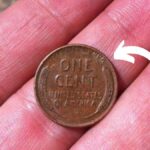Every day, countless coins pass through our hands without a second thought. Yet among these common pieces of currency lie some extraordinary treasures, particularly within the Lincoln Wheat Penny series. These small copper coins, which might seem unremarkable at first glance, can sometimes be worth far more than their one-cent face value. Let’s explore the fascinating world of these valuable pennies and discover what makes certain ones so special.
The Birth of the Lincoln Wheat Penny
In 1909, the United States Mint introduced the Lincoln Wheat Penny to commemorate President Abraham Lincoln’s 100th birthday. The coin’s design featured Lincoln’s profile on the front and two wheat stalks on the back, symbolizing America’s agricultural heritage. For nearly fifty years, until 1958, these pennies were a common sight in American pockets and cash registers. Today, they’ve become highly sought-after collectibles, with some rare versions commanding remarkable prices.
The Million-Dollar Penny: The 1943 Bronze Rarity
Perhaps no Lincoln Wheat Penny is more famous or valuable than the 1943 Bronze version. During World War II, the U.S. government needed copper for military equipment, so they switched to making pennies from zinc-coated steel. However, a handful of bronze planchets (coin blanks) from 1942 accidentally made their way into the 1943 production line. This mistake created one of the most valuable coins in American history, with one exceptional example selling for $388,888 at auction. To check if you have a genuine 1943 Bronze Penny, try the simple magnet test – if the penny sticks to the magnet, it’s the common steel version, not the rare bronze one.
Early Rarities: The 1909-S VDB Story
The very first year of Lincoln Wheat Penny production yielded another highly valuable coin: the 1909-S VDB. The designer, Victor David Brenner, placed his initials (VDB) on the reverse of the coin, but public criticism led to their quick removal. Only 484,000 pennies were minted with these initials at the San Francisco Mint, making them extremely rare today. Well-preserved examples can sell for more than $88,888, demonstrating how a simple design change can create numismatic history.
Depression-Era Gems: The 1931-S Lincoln Penny
The Great Depression’s impact on coin production created another valuable penny. In 1931, as the economy struggled, the San Francisco Mint produced only 866,000 pennies – a tiny number compared to normal production levels. This limited mintage has made the 1931-S Lincoln Penny highly desirable among collectors, with top-quality examples worth over $88,888. The coin serves as a tangible reminder of one of America’s most challenging economic periods.
Mistakes Worth a Fortune: The 1955 Doubled Die Penny
Sometimes, mint errors create valuable treasures. The 1955 Doubled Die Penny shows clear doubling of the date and lettering, caused by a misalignment during the minting process. This striking error makes the coin easily identifiable even to novice collectors. Despite being a mistake, or perhaps because of it, these coins can command prices exceeding $88,888 when in excellent condition. It’s a perfect example of how imperfection can sometimes be more valuable than perfection.
World War II Mix-Ups: The 1944 Steel Penny
After returning to copper production in 1944, a few pennies were accidentally struck on leftover steel planchets from the previous year. These 1944 Steel Pennies are extremely rare and highly valued by collectors. The mistake is similar to the 1943 Bronze Penny but in reverse, showing how wartime production changes sometimes led to valuable errors. Well-preserved examples of these steel stragglers can fetch more than $88,888.
Understanding What Makes a Penny Valuable
Several factors determine a Lincoln Wheat Penny’s value. Rarity is crucial – the fewer examples that exist, the more valuable they tend to be. Condition also plays a vital role, with coins showing minimal wear commanding the highest prices. Historical significance adds another layer of value, especially for coins that tell interesting stories about American history, like the wartime composition changes.
Starting Your Own Collection
For those interested in collecting Lincoln Wheat Pennies, it’s important to start with good research and the right tools. A quality magnifying glass helps examine coins for important details and potential errors. Learning about coin grading and authentication can prevent costly mistakes, especially when dealing with rare varieties. Many collectors begin by checking their pocket change and gradually expand to purchasing from reputable dealers.
The Historical Legacy
These valuable pennies represent more than just monetary worth. They tell stories of American history, from the Great Depression to World War II. Each rare variety offers insights into the technological, economic, and social conditions of its time. When we hold one of these pennies, we’re holding a piece of history that connects us to important moments in our nation’s past.
Preserving Value for the Future
For those lucky enough to find or own valuable Lincoln Wheat Pennies, proper storage and handling are essential. Coins should be kept in appropriate holders that protect them from environmental damage. Professional grading services can authenticate rare specimens and provide protective encapsulation, helping preserve their value for future generations.
A Word of Caution
While the stories of valuable Lincoln Wheat Pennies are exciting, it’s important to remember that most examples are worth only a few cents. Many factors influence a coin’s value, and professional authentication is crucial for rare varieties. The market for these coins can also fluctuate, so values mentioned here should be considered guidelines rather than guarantees.
In conclusion, the world of Lincoln Wheat Pennies offers fascinating opportunities for both collectors and history enthusiasts. While finding a rare and valuable example might be unlikely, understanding their history and significance adds depth to our appreciation of American numismatic heritage. Whether worth hundreds of thousands of dollars or just a single cent, each Lincoln Wheat Penny carries a piece of American history worth preserving.








